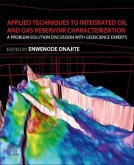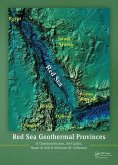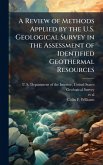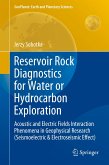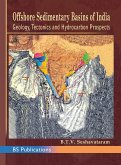Geophysical Exploration for Hydrocarbon Reservoirs, Geothermal Energy, and Carbon Storage
New Technologies and Ai-Based Approaches
Herausgeber: Gaci, Said
Geophysical Exploration for Hydrocarbon Reservoirs, Geothermal Energy, and Carbon Storage
New Technologies and Ai-Based Approaches
Herausgeber: Gaci, Said
- Gebundenes Buch
- Merkliste
- Auf die Merkliste
- Bewerten Bewerten
- Teilen
- Produkt teilen
- Produkterinnerung
- Produkterinnerung
A practical guide to the latest technologies and techniques in subsurface energy exploration In Geophysical Exploration for Hydrocarbon Reservoirs, Geothermal Energy, and Carbon Storage: New Technologies and AI-based Approaches, distinguished researcher Said Gaci delivers a practice-oriented overview and comparison of the concepts, methods, and workflows for the geophysical characterization of hydrocarbon and geothermal reservoirs, including those reservoirs suitable for large-scale carbon sequestration. Organized into four parts, the book begins with a summary of novel petroleum exploration…mehr
Andere Kunden interessierten sich auch für
![Geophysical Interpretation Using Integral Equations Geophysical Interpretation Using Integral Equations]() L. EskolaGeophysical Interpretation Using Integral Equations61,99 €
L. EskolaGeophysical Interpretation Using Integral Equations61,99 €![Applied High-Resolution Geophysical Methods Applied High-Resolution Geophysical Methods]() P. K. TrabantApplied High-Resolution Geophysical Methods39,99 €
P. K. TrabantApplied High-Resolution Geophysical Methods39,99 €![Applied Techniques to Integrated Oil and Gas Reservoir Characterization Applied Techniques to Integrated Oil and Gas Reservoir Characterization]() Applied Techniques to Integrated Oil and Gas Reservoir Characterization101,99 €
Applied Techniques to Integrated Oil and Gas Reservoir Characterization101,99 €![Red Sea Geothermal Provinces Red Sea Geothermal Provinces]() D. ChandrasekharamRed Sea Geothermal Provinces164,99 €
D. ChandrasekharamRed Sea Geothermal Provinces164,99 €![A Review of Methods Applied by the U.S. Geological Survey in the Assessment of Identified Geothermal Resources A Review of Methods Applied by the U.S. Geological Survey in the Assessment of Identified Geothermal Resources]() Colin F WilliamsA Review of Methods Applied by the U.S. Geological Survey in the Assessment of Identified Geothermal Resources25,99 €
Colin F WilliamsA Review of Methods Applied by the U.S. Geological Survey in the Assessment of Identified Geothermal Resources25,99 €![Reservoir Rock Diagnostics for Water or Hydrocarbon Exploration Reservoir Rock Diagnostics for Water or Hydrocarbon Exploration]() Jerzy SobotkaReservoir Rock Diagnostics for Water or Hydrocarbon Exploration76,99 €
Jerzy SobotkaReservoir Rock Diagnostics for Water or Hydrocarbon Exploration76,99 €![Offshore Sedimentary Basins of India Geology, Tectonics and Hydrocarbon Prospects Offshore Sedimentary Basins of India Geology, Tectonics and Hydrocarbon Prospects]() B T. V SeshavataramOffshore Sedimentary Basins of India Geology, Tectonics and Hydrocarbon Prospects150,99 €
B T. V SeshavataramOffshore Sedimentary Basins of India Geology, Tectonics and Hydrocarbon Prospects150,99 €-
-
-
A practical guide to the latest technologies and techniques in subsurface energy exploration In Geophysical Exploration for Hydrocarbon Reservoirs, Geothermal Energy, and Carbon Storage: New Technologies and AI-based Approaches, distinguished researcher Said Gaci delivers a practice-oriented overview and comparison of the concepts, methods, and workflows for the geophysical characterization of hydrocarbon and geothermal reservoirs, including those reservoirs suitable for large-scale carbon sequestration. Organized into four parts, the book begins with a summary of novel petroleum exploration technologies and discussions of illustrative case studies from around the world. It then explains how to integrate seismic and other non-invasive surveying methods for a comprehensive multiscale reservoir characterization. The third part explores the implementation of artificial intelligence tools in remote exploration, rock typing, and fluid prediction. The final part demonstrates how to apply hydrocarbon exploration methods to the exploration and development of geothermal reservoirs and underground carbon dioxide storage sites. Readers will find: * A multidisciplinary approach to combining conventional hydrocarbon exploration techniques with the power of artificial intelligence * A thorough understanding of subsurface reservoir systems that links recent technical advances with new geological insights * Practice-oriented discussions of advanced technologies for non-invasive reservoir characterization * Selected case studies that illustrate the application of novel concepts in a real-world setting Perfect for geologists, geoengineers, geophysicists, and fossil fuel professionals, Geophysical Exploration for Hydrocarbon Reservoirs, Geothermal Energy, and Carbon Storage will also benefit anyone aiming to remain at the forefront of subsurface energy exploration in the twenty-first century.
Produktdetails
- Produktdetails
- Verlag: Wiley
- Seitenzahl: 528
- Erscheinungstermin: 25. August 2025
- Englisch
- ISBN-13: 9781394261536
- ISBN-10: 1394261535
- Artikelnr.: 72544009
- Herstellerkennzeichnung
- Libri GmbH
- Europaallee 1
- 36244 Bad Hersfeld
- gpsr@libri.de
- Verlag: Wiley
- Seitenzahl: 528
- Erscheinungstermin: 25. August 2025
- Englisch
- ISBN-13: 9781394261536
- ISBN-10: 1394261535
- Artikelnr.: 72544009
- Herstellerkennzeichnung
- Libri GmbH
- Europaallee 1
- 36244 Bad Hersfeld
- gpsr@libri.de
Said Gaci, PhD, is the Director of Scientific and Technical Support to Research at Sonatrach's Central Research and Development Directorate (DC R&D). His research interests include the application of signal processing and pattern recognition techniques in the geosciences.
List of Contributors xvii
Preface xix
About the Book xxi
Section I New Technologies and Insights into Petroleum Exploration 1
1 Gas Seepage in Marginal Structures as Additional Shallow and Deep
Hydrocarbon Systems Indicator (Some of Recent FR Scanning Results) 3
Valery Soloviev, Mykola Yakymchuk, Ignat Korchagin
1.1 Introduction 3
1.2 General Principles and Methods 4
1.3 Gas Fluids as Additional Hydrocarbon Processes Indicator in Some
Continental Margin Structures 4
1.4 Conclusions 24
Author Contributions 24
Conflict of Interests 25
References 25
2 The Role of the LVZ and of Increased Seismicity in the Localization of
Abiogenic HC in the Crystalline Crust of Transcarpathia 29
Valeriy Korchin, Elena Karnaukhova
2.1 Introduction 29
2.2 Basic Principles of Petrophysical Thermobaric Modeling 30
2.3 Influence of п-Regimes on the Elastic Characteristics and Density of
Rocks 30
2.4 The LVZs in the Crystalline Crust as Zones of Increased Porosity of
Mineral Matter 34
2.5 A Comparison of Experimental Data and Geophysical Observations 36
2.6 Geological Interpretation of the PTBM Results 37
2.7 The Nature of LVZ along the DSS Profile (RP-17) Using the PTBM
Methodology 39
2.8 Elastic Characteristics of the Mineral Substance along the DSS Profile
(RP-17) 42
2.9 Conclusions 44
References 45
3 Precambrian Mid-Continent Rift Potential for Hosting Numerous Helium and
Hydrogen Accumulations, Central USA 49
Steven A. Tedesco
3.1 Introduction 50
3.2 The Formation of the Mid-Continent Rift System 51
3.3 Geology 52
3.4 Wells of Interest 57
3.5 Trap and Seal 59
3.6 Gravity/Magnetics 61
3.7 Seismic 62
3.8 Oil and Gas Exploration and Production 64
3.9 Iron and Base Metals 65
3.10 Impact Craters 65
3.11 Helium 65
3.12 Hydrogen 67
3.13 Summary 70
References 70
4 Production from Desmoinesian and Atokan Age Coalbed Methane and
Carbonaceous Mudstone and Their Relationship to Structure and Geologic
History of the Cherokee Basin, Kansas and Oklahoma, USA 73
Steven A. Tedesco
4.1 Introduction 73
4.2 Geology 75
4.3 Production 79
4.4 Drilling and Completion Methods 84
4.5 Jefferson-Sycamore Area 85
4.6 Discussion 91
References 97
5 Geophysical Research and Monitoring Within the Framework of a
Block-Layered Model with Inclusions of a Hierarchical Structure 99
Olga Hachay, Andrey Khachay
5.1 Review 99
5.2 Conclusions 102
References 102
Section II Reservoir Characterization Concepts and Workflows 105
6 A Review on Shear Wave Velocity Estimation Methods 107
Said Gaci, Mohammed Farfour
6.1 Introduction 107
6.2 Empirical Relationships for Estimating S-Wave Velocity 108
6.3 Intelligent Systems for Estimating S-Wave Velocity 111
6.4 Rock Physics Models for Estimating S-Wave Velocity 113
6.5 Example 116
6.6 Conclusions 119
References 119
7 Geomechanics in Petroleum Exploration, Development, and Energy Transition
125
Ghoulem Ifrene, Kuldeep Singh
7.1 Introduction 125
7.2 Role of Geomechanics in Exploration and Development 126
7.3 Enhancing Reservoir Performance Through Geomechanics 130
7.4 Predictive Analyses and Production Optimization 131
7.5 Unconventional Hydrocarbon Reservoirs and Geomechanics 134
7.6 Geomechanics in Geological Carbon Storage 140
7.7 Geomechanics of Hydrogen Storage and Production 145
7.8 Conclusions 149
References 150
8 Size Scaling and Spatial Clustering of Natural Fracture Networks Using
Fractal Analysis 161
Sofiane Djezzar, Aldjia Boualam
8.1 Introduction 161
8.2 Geological Settings 162
8.3 Methods and Approaches 163
8.4 Fractal Analysis 164
8.5 Conclusions 178
References 182
9 Application of Seismic Attributes on Digital Elevation Model: Fractures
Detection and Reservoir Implication 185
Sofiane Djezzar, Aldjia Boualam
9.1 Introduction 185
9.2 Problematic 186
9.3 Workflow and Methodology 187
9.4 Fault Detection Techniques 190
9.5 Fault Analysis 191
9.6 Fracture Intensity and Density Analysis 196
9.7 Fracture Connectivity, Permeability, and Wavelet Analysis 197
9.8 Discussion 199
9.9 Conclusions 200
References 201
10 Structural Analysis and Fracture Kinematics Using Seismic 2D and
Geological Maps 205
Sofiane Djezzar, Aldjia Boualam
10.1 Introduction 205
10.2 Material and Methods 206
10.3 Geological Settings 207
10.4 Gravity Data 208
10.5 Structural Analysis 210
10.6 Seismic Data Analysis 212
10.7 Fault Analysis 216
10.8 Conclusions 217
References 218
11 A New Method for Reservoir Fracture Characterization and Modeling Using
Surface Analog 221
Sofiane Djezzar, Aldjia Boualam
11.1 Introduction 221
11.2 Methodology 222
11.3 Geological Background 223
11.4 Material and Methods 224
11.5 Data Analysis 225
11.6 3D Fracture Models 232
11.7 Discussion and Conclusions 233
References 235
12 An Integrated Workflow for Multiscale Fracture Analysis in Reservoir
Analog 237
Sofiane Djezzar, Aldjia Boualam
12.1 Introduction 237
12.2 Geological Background 238
12.3 Material and Method 240
12.4 Fracture Characterization 241
12.5 Fracture Analysis 246
12.6 Fractal Analysis 248
12.7 3D Fault Models 249
12.8 Discussion 249
12.9 Conclusions 251
References 251
Section III Artificial Intelligence Applied to Reservoir Characterization
257
13 Exploring the Depths: Satellite Image Processing and Artificial
Intelligence in the Oil and Gas Industry 259
Hasna Yazid, Said Gaci
13.1 Introduction 259
13.2 Overview of Satellite Technology 260
13.3 Evolution of Satellite Technology in the Oil and Gas Industry 261
13.4 Satellite Image Processing Techniques 262
13.5 Artificial Intelligence in Satellite Imagery Processing 264
13.6 Practical Applications and AI in the Oil and Gas Industry 266
13.7 Conclusions 273
References 275
14 Modern AI Usage in the Oil and Gas Industry for Reservoir
Characterization and Lithofacies Forecasting (Rock Typing) 281
Hasna Yazid, Said Gaci, Mohammed Farfour
14.1 Introduction 281
14.2 Workflow of Rock Typing Using Machine Learning 284
14.3 Application 285
14.4 Conclusions 297
Acknowledgment 299
References 299
15 Logging-Data-Driven Fluid Prediction in Clastic Reservoir Based on
Fractal Attributes and Machine Learning Methods 303
Abdelbasset Boulassel, Soraya Makhlouf, Fethi Ali Cheddad, Zinelaabidine
Boumelit, Badis Zegagh, Salah Boufenchouche, Amar Boudella, Naima Zaourar,
Said Gaci
15.1 Introduction 303
15.2 Studied Dataset 304
15.3 Overview of Fractal Analysis Steps Employed in Geophysical Well Logs
Study 305
15.4 Overview of Employed Machine Learning Methods 307
15.5 Model Evaluation 309
15.6 Results and Discussion 311
15.7 Conclusions 318
Acknowledgment 318
References 318
16 Unlocking Deeper Insights: Using Machine Learning to Predict Dynamic
Shear Wave Slowness from Well Logs 323
Abdelbasset Boulassel, Soraya Makhlouf, Zinelaabidine Boumelit, Badis
Zegagh, Salah Boufenchouche, Fethi Ali Cheddad, Amar Boudella, Naima
Zaourar, Said Gaci
16.1 Introduction 323
16.2 Studied Wells and Dataset 324
16.3 Overview of Employed Machine Learning Methods 325
16.4 Model Evaluation 328
16.5 Results and Discussion 330
16.6 Conclusions 338
Acknowledgment 338
References 338
Section IV Energy transition: New Perspectives on Geothermal Energy
Exploration and Development and CO2 Sequestration 343
17 Energy Transition and the Role of AI: Statistics, Trends, and
Implications 345
Said Gaci, Hasna Yazid, Aziz Khelalef , Mohammed Farfour
17.1 Introduction 345
17.2 Objectives for the Energy Transition 345
17.3 Emerging Trends of Energy Transition and AI 346
17.4 Implications of Leveraging AI in Energy Transition 348
17.5 Challenges to Apply AI in Renewable Energy Sector 348
17.6 Conclusions 351
References 352
18 On the Importance of Integrating Geomodeling in Geothermal Studies 355
Mohamed Amrouche
18.1 Introduction 355
18.2 Geology of Geothermal Provinces 356
18.3 Exploration of Geothermal Reservoirs 358
18.4 Modeling the Subsurface of Geothermal Reservoirs 361
18.5 Concepts of 3D Geocellular Modeling 363
18.6 Geophysical Modeling with the 3D Geocellular Grid 367
18.7 Faults and Fracture Network Modeling with the 3D Geocellular Grid 370
18.8 Updating the Property Models with Integrated Workflows 373
18.9 Conclusions 374
References 375
19 Advancements, Challenges, and Outlook of Geothermal Reservoir Operations
379
Ghoulem Ifrene, Singh Kuldeep, William Gosnold
19.1 Introduction 379
19.2 Geomechanical Considerations of Geothermal Reservoirs 382
19.3 Drilling and Well Completion Technologies 390
19.4 Production and Injection Optimization 392
19.5 Future Directions and Research Needs 398
19.6 Environmental and Social Considerations for Geothermal Energy
Development 403
References 409
20 Multiscale Reservoir Characterization of a CO2 Storage Aquifer:
Mineralogical, Geomechanical, and Petrophysical Analyses for a CCS Project
in North Dakota? 417
Aimen Laalam, Ahmed Merzoug, Hichem Aymen Katib Chellal
20.1 Introduction 417
20.2 CCS Overview 418
20.3 Case Study: Carbon Storage in the Broom Creek Saline Aquifer,
Williston Basin, North Dakota 425
20.4 Conclusions 444
References 444
21 Anthropogenic Carbon Sequestration into the Subsurface: Caveats and
Pitfalls 451
Steven A. Tedesco
21.1 Introduction 451
21.2 CO2 Incentives 452
21.3 Chemistry 452
21.4 Carbon Dioxide 453
21.5 Potential Sequestration Locations 455
21.6 Sequestration in Hydrocarbon and Carbon Dioxide Reservoirs 456
21.7 Risk Assessment Analysis and Characterization of a Reservoir for CO2
Sequestration 458
21.8 Sequestration in Saline Aquifers 461
21.9 Sequestration in Coal Seams 465
21.10 Sequestration in Carbonaceous Mudstones 468
21.11 Mineral Sequestration 470
21.12 Sequestration in Oceans 471
21.13 Sequestration in Soils 471
21.14 Class VI Wells 471
21.15 Case Histories/Models 473
21.16 Summary 482
References 483
Index 489
Preface xix
About the Book xxi
Section I New Technologies and Insights into Petroleum Exploration 1
1 Gas Seepage in Marginal Structures as Additional Shallow and Deep
Hydrocarbon Systems Indicator (Some of Recent FR Scanning Results) 3
Valery Soloviev, Mykola Yakymchuk, Ignat Korchagin
1.1 Introduction 3
1.2 General Principles and Methods 4
1.3 Gas Fluids as Additional Hydrocarbon Processes Indicator in Some
Continental Margin Structures 4
1.4 Conclusions 24
Author Contributions 24
Conflict of Interests 25
References 25
2 The Role of the LVZ and of Increased Seismicity in the Localization of
Abiogenic HC in the Crystalline Crust of Transcarpathia 29
Valeriy Korchin, Elena Karnaukhova
2.1 Introduction 29
2.2 Basic Principles of Petrophysical Thermobaric Modeling 30
2.3 Influence of п-Regimes on the Elastic Characteristics and Density of
Rocks 30
2.4 The LVZs in the Crystalline Crust as Zones of Increased Porosity of
Mineral Matter 34
2.5 A Comparison of Experimental Data and Geophysical Observations 36
2.6 Geological Interpretation of the PTBM Results 37
2.7 The Nature of LVZ along the DSS Profile (RP-17) Using the PTBM
Methodology 39
2.8 Elastic Characteristics of the Mineral Substance along the DSS Profile
(RP-17) 42
2.9 Conclusions 44
References 45
3 Precambrian Mid-Continent Rift Potential for Hosting Numerous Helium and
Hydrogen Accumulations, Central USA 49
Steven A. Tedesco
3.1 Introduction 50
3.2 The Formation of the Mid-Continent Rift System 51
3.3 Geology 52
3.4 Wells of Interest 57
3.5 Trap and Seal 59
3.6 Gravity/Magnetics 61
3.7 Seismic 62
3.8 Oil and Gas Exploration and Production 64
3.9 Iron and Base Metals 65
3.10 Impact Craters 65
3.11 Helium 65
3.12 Hydrogen 67
3.13 Summary 70
References 70
4 Production from Desmoinesian and Atokan Age Coalbed Methane and
Carbonaceous Mudstone and Their Relationship to Structure and Geologic
History of the Cherokee Basin, Kansas and Oklahoma, USA 73
Steven A. Tedesco
4.1 Introduction 73
4.2 Geology 75
4.3 Production 79
4.4 Drilling and Completion Methods 84
4.5 Jefferson-Sycamore Area 85
4.6 Discussion 91
References 97
5 Geophysical Research and Monitoring Within the Framework of a
Block-Layered Model with Inclusions of a Hierarchical Structure 99
Olga Hachay, Andrey Khachay
5.1 Review 99
5.2 Conclusions 102
References 102
Section II Reservoir Characterization Concepts and Workflows 105
6 A Review on Shear Wave Velocity Estimation Methods 107
Said Gaci, Mohammed Farfour
6.1 Introduction 107
6.2 Empirical Relationships for Estimating S-Wave Velocity 108
6.3 Intelligent Systems for Estimating S-Wave Velocity 111
6.4 Rock Physics Models for Estimating S-Wave Velocity 113
6.5 Example 116
6.6 Conclusions 119
References 119
7 Geomechanics in Petroleum Exploration, Development, and Energy Transition
125
Ghoulem Ifrene, Kuldeep Singh
7.1 Introduction 125
7.2 Role of Geomechanics in Exploration and Development 126
7.3 Enhancing Reservoir Performance Through Geomechanics 130
7.4 Predictive Analyses and Production Optimization 131
7.5 Unconventional Hydrocarbon Reservoirs and Geomechanics 134
7.6 Geomechanics in Geological Carbon Storage 140
7.7 Geomechanics of Hydrogen Storage and Production 145
7.8 Conclusions 149
References 150
8 Size Scaling and Spatial Clustering of Natural Fracture Networks Using
Fractal Analysis 161
Sofiane Djezzar, Aldjia Boualam
8.1 Introduction 161
8.2 Geological Settings 162
8.3 Methods and Approaches 163
8.4 Fractal Analysis 164
8.5 Conclusions 178
References 182
9 Application of Seismic Attributes on Digital Elevation Model: Fractures
Detection and Reservoir Implication 185
Sofiane Djezzar, Aldjia Boualam
9.1 Introduction 185
9.2 Problematic 186
9.3 Workflow and Methodology 187
9.4 Fault Detection Techniques 190
9.5 Fault Analysis 191
9.6 Fracture Intensity and Density Analysis 196
9.7 Fracture Connectivity, Permeability, and Wavelet Analysis 197
9.8 Discussion 199
9.9 Conclusions 200
References 201
10 Structural Analysis and Fracture Kinematics Using Seismic 2D and
Geological Maps 205
Sofiane Djezzar, Aldjia Boualam
10.1 Introduction 205
10.2 Material and Methods 206
10.3 Geological Settings 207
10.4 Gravity Data 208
10.5 Structural Analysis 210
10.6 Seismic Data Analysis 212
10.7 Fault Analysis 216
10.8 Conclusions 217
References 218
11 A New Method for Reservoir Fracture Characterization and Modeling Using
Surface Analog 221
Sofiane Djezzar, Aldjia Boualam
11.1 Introduction 221
11.2 Methodology 222
11.3 Geological Background 223
11.4 Material and Methods 224
11.5 Data Analysis 225
11.6 3D Fracture Models 232
11.7 Discussion and Conclusions 233
References 235
12 An Integrated Workflow for Multiscale Fracture Analysis in Reservoir
Analog 237
Sofiane Djezzar, Aldjia Boualam
12.1 Introduction 237
12.2 Geological Background 238
12.3 Material and Method 240
12.4 Fracture Characterization 241
12.5 Fracture Analysis 246
12.6 Fractal Analysis 248
12.7 3D Fault Models 249
12.8 Discussion 249
12.9 Conclusions 251
References 251
Section III Artificial Intelligence Applied to Reservoir Characterization
257
13 Exploring the Depths: Satellite Image Processing and Artificial
Intelligence in the Oil and Gas Industry 259
Hasna Yazid, Said Gaci
13.1 Introduction 259
13.2 Overview of Satellite Technology 260
13.3 Evolution of Satellite Technology in the Oil and Gas Industry 261
13.4 Satellite Image Processing Techniques 262
13.5 Artificial Intelligence in Satellite Imagery Processing 264
13.6 Practical Applications and AI in the Oil and Gas Industry 266
13.7 Conclusions 273
References 275
14 Modern AI Usage in the Oil and Gas Industry for Reservoir
Characterization and Lithofacies Forecasting (Rock Typing) 281
Hasna Yazid, Said Gaci, Mohammed Farfour
14.1 Introduction 281
14.2 Workflow of Rock Typing Using Machine Learning 284
14.3 Application 285
14.4 Conclusions 297
Acknowledgment 299
References 299
15 Logging-Data-Driven Fluid Prediction in Clastic Reservoir Based on
Fractal Attributes and Machine Learning Methods 303
Abdelbasset Boulassel, Soraya Makhlouf, Fethi Ali Cheddad, Zinelaabidine
Boumelit, Badis Zegagh, Salah Boufenchouche, Amar Boudella, Naima Zaourar,
Said Gaci
15.1 Introduction 303
15.2 Studied Dataset 304
15.3 Overview of Fractal Analysis Steps Employed in Geophysical Well Logs
Study 305
15.4 Overview of Employed Machine Learning Methods 307
15.5 Model Evaluation 309
15.6 Results and Discussion 311
15.7 Conclusions 318
Acknowledgment 318
References 318
16 Unlocking Deeper Insights: Using Machine Learning to Predict Dynamic
Shear Wave Slowness from Well Logs 323
Abdelbasset Boulassel, Soraya Makhlouf, Zinelaabidine Boumelit, Badis
Zegagh, Salah Boufenchouche, Fethi Ali Cheddad, Amar Boudella, Naima
Zaourar, Said Gaci
16.1 Introduction 323
16.2 Studied Wells and Dataset 324
16.3 Overview of Employed Machine Learning Methods 325
16.4 Model Evaluation 328
16.5 Results and Discussion 330
16.6 Conclusions 338
Acknowledgment 338
References 338
Section IV Energy transition: New Perspectives on Geothermal Energy
Exploration and Development and CO2 Sequestration 343
17 Energy Transition and the Role of AI: Statistics, Trends, and
Implications 345
Said Gaci, Hasna Yazid, Aziz Khelalef , Mohammed Farfour
17.1 Introduction 345
17.2 Objectives for the Energy Transition 345
17.3 Emerging Trends of Energy Transition and AI 346
17.4 Implications of Leveraging AI in Energy Transition 348
17.5 Challenges to Apply AI in Renewable Energy Sector 348
17.6 Conclusions 351
References 352
18 On the Importance of Integrating Geomodeling in Geothermal Studies 355
Mohamed Amrouche
18.1 Introduction 355
18.2 Geology of Geothermal Provinces 356
18.3 Exploration of Geothermal Reservoirs 358
18.4 Modeling the Subsurface of Geothermal Reservoirs 361
18.5 Concepts of 3D Geocellular Modeling 363
18.6 Geophysical Modeling with the 3D Geocellular Grid 367
18.7 Faults and Fracture Network Modeling with the 3D Geocellular Grid 370
18.8 Updating the Property Models with Integrated Workflows 373
18.9 Conclusions 374
References 375
19 Advancements, Challenges, and Outlook of Geothermal Reservoir Operations
379
Ghoulem Ifrene, Singh Kuldeep, William Gosnold
19.1 Introduction 379
19.2 Geomechanical Considerations of Geothermal Reservoirs 382
19.3 Drilling and Well Completion Technologies 390
19.4 Production and Injection Optimization 392
19.5 Future Directions and Research Needs 398
19.6 Environmental and Social Considerations for Geothermal Energy
Development 403
References 409
20 Multiscale Reservoir Characterization of a CO2 Storage Aquifer:
Mineralogical, Geomechanical, and Petrophysical Analyses for a CCS Project
in North Dakota? 417
Aimen Laalam, Ahmed Merzoug, Hichem Aymen Katib Chellal
20.1 Introduction 417
20.2 CCS Overview 418
20.3 Case Study: Carbon Storage in the Broom Creek Saline Aquifer,
Williston Basin, North Dakota 425
20.4 Conclusions 444
References 444
21 Anthropogenic Carbon Sequestration into the Subsurface: Caveats and
Pitfalls 451
Steven A. Tedesco
21.1 Introduction 451
21.2 CO2 Incentives 452
21.3 Chemistry 452
21.4 Carbon Dioxide 453
21.5 Potential Sequestration Locations 455
21.6 Sequestration in Hydrocarbon and Carbon Dioxide Reservoirs 456
21.7 Risk Assessment Analysis and Characterization of a Reservoir for CO2
Sequestration 458
21.8 Sequestration in Saline Aquifers 461
21.9 Sequestration in Coal Seams 465
21.10 Sequestration in Carbonaceous Mudstones 468
21.11 Mineral Sequestration 470
21.12 Sequestration in Oceans 471
21.13 Sequestration in Soils 471
21.14 Class VI Wells 471
21.15 Case Histories/Models 473
21.16 Summary 482
References 483
Index 489
List of Contributors xvii
Preface xix
About the Book xxi
Section I New Technologies and Insights into Petroleum Exploration 1
1 Gas Seepage in Marginal Structures as Additional Shallow and Deep
Hydrocarbon Systems Indicator (Some of Recent FR Scanning Results) 3
Valery Soloviev, Mykola Yakymchuk, Ignat Korchagin
1.1 Introduction 3
1.2 General Principles and Methods 4
1.3 Gas Fluids as Additional Hydrocarbon Processes Indicator in Some
Continental Margin Structures 4
1.4 Conclusions 24
Author Contributions 24
Conflict of Interests 25
References 25
2 The Role of the LVZ and of Increased Seismicity in the Localization of
Abiogenic HC in the Crystalline Crust of Transcarpathia 29
Valeriy Korchin, Elena Karnaukhova
2.1 Introduction 29
2.2 Basic Principles of Petrophysical Thermobaric Modeling 30
2.3 Influence of п-Regimes on the Elastic Characteristics and Density of
Rocks 30
2.4 The LVZs in the Crystalline Crust as Zones of Increased Porosity of
Mineral Matter 34
2.5 A Comparison of Experimental Data and Geophysical Observations 36
2.6 Geological Interpretation of the PTBM Results 37
2.7 The Nature of LVZ along the DSS Profile (RP-17) Using the PTBM
Methodology 39
2.8 Elastic Characteristics of the Mineral Substance along the DSS Profile
(RP-17) 42
2.9 Conclusions 44
References 45
3 Precambrian Mid-Continent Rift Potential for Hosting Numerous Helium and
Hydrogen Accumulations, Central USA 49
Steven A. Tedesco
3.1 Introduction 50
3.2 The Formation of the Mid-Continent Rift System 51
3.3 Geology 52
3.4 Wells of Interest 57
3.5 Trap and Seal 59
3.6 Gravity/Magnetics 61
3.7 Seismic 62
3.8 Oil and Gas Exploration and Production 64
3.9 Iron and Base Metals 65
3.10 Impact Craters 65
3.11 Helium 65
3.12 Hydrogen 67
3.13 Summary 70
References 70
4 Production from Desmoinesian and Atokan Age Coalbed Methane and
Carbonaceous Mudstone and Their Relationship to Structure and Geologic
History of the Cherokee Basin, Kansas and Oklahoma, USA 73
Steven A. Tedesco
4.1 Introduction 73
4.2 Geology 75
4.3 Production 79
4.4 Drilling and Completion Methods 84
4.5 Jefferson-Sycamore Area 85
4.6 Discussion 91
References 97
5 Geophysical Research and Monitoring Within the Framework of a
Block-Layered Model with Inclusions of a Hierarchical Structure 99
Olga Hachay, Andrey Khachay
5.1 Review 99
5.2 Conclusions 102
References 102
Section II Reservoir Characterization Concepts and Workflows 105
6 A Review on Shear Wave Velocity Estimation Methods 107
Said Gaci, Mohammed Farfour
6.1 Introduction 107
6.2 Empirical Relationships for Estimating S-Wave Velocity 108
6.3 Intelligent Systems for Estimating S-Wave Velocity 111
6.4 Rock Physics Models for Estimating S-Wave Velocity 113
6.5 Example 116
6.6 Conclusions 119
References 119
7 Geomechanics in Petroleum Exploration, Development, and Energy Transition
125
Ghoulem Ifrene, Kuldeep Singh
7.1 Introduction 125
7.2 Role of Geomechanics in Exploration and Development 126
7.3 Enhancing Reservoir Performance Through Geomechanics 130
7.4 Predictive Analyses and Production Optimization 131
7.5 Unconventional Hydrocarbon Reservoirs and Geomechanics 134
7.6 Geomechanics in Geological Carbon Storage 140
7.7 Geomechanics of Hydrogen Storage and Production 145
7.8 Conclusions 149
References 150
8 Size Scaling and Spatial Clustering of Natural Fracture Networks Using
Fractal Analysis 161
Sofiane Djezzar, Aldjia Boualam
8.1 Introduction 161
8.2 Geological Settings 162
8.3 Methods and Approaches 163
8.4 Fractal Analysis 164
8.5 Conclusions 178
References 182
9 Application of Seismic Attributes on Digital Elevation Model: Fractures
Detection and Reservoir Implication 185
Sofiane Djezzar, Aldjia Boualam
9.1 Introduction 185
9.2 Problematic 186
9.3 Workflow and Methodology 187
9.4 Fault Detection Techniques 190
9.5 Fault Analysis 191
9.6 Fracture Intensity and Density Analysis 196
9.7 Fracture Connectivity, Permeability, and Wavelet Analysis 197
9.8 Discussion 199
9.9 Conclusions 200
References 201
10 Structural Analysis and Fracture Kinematics Using Seismic 2D and
Geological Maps 205
Sofiane Djezzar, Aldjia Boualam
10.1 Introduction 205
10.2 Material and Methods 206
10.3 Geological Settings 207
10.4 Gravity Data 208
10.5 Structural Analysis 210
10.6 Seismic Data Analysis 212
10.7 Fault Analysis 216
10.8 Conclusions 217
References 218
11 A New Method for Reservoir Fracture Characterization and Modeling Using
Surface Analog 221
Sofiane Djezzar, Aldjia Boualam
11.1 Introduction 221
11.2 Methodology 222
11.3 Geological Background 223
11.4 Material and Methods 224
11.5 Data Analysis 225
11.6 3D Fracture Models 232
11.7 Discussion and Conclusions 233
References 235
12 An Integrated Workflow for Multiscale Fracture Analysis in Reservoir
Analog 237
Sofiane Djezzar, Aldjia Boualam
12.1 Introduction 237
12.2 Geological Background 238
12.3 Material and Method 240
12.4 Fracture Characterization 241
12.5 Fracture Analysis 246
12.6 Fractal Analysis 248
12.7 3D Fault Models 249
12.8 Discussion 249
12.9 Conclusions 251
References 251
Section III Artificial Intelligence Applied to Reservoir Characterization
257
13 Exploring the Depths: Satellite Image Processing and Artificial
Intelligence in the Oil and Gas Industry 259
Hasna Yazid, Said Gaci
13.1 Introduction 259
13.2 Overview of Satellite Technology 260
13.3 Evolution of Satellite Technology in the Oil and Gas Industry 261
13.4 Satellite Image Processing Techniques 262
13.5 Artificial Intelligence in Satellite Imagery Processing 264
13.6 Practical Applications and AI in the Oil and Gas Industry 266
13.7 Conclusions 273
References 275
14 Modern AI Usage in the Oil and Gas Industry for Reservoir
Characterization and Lithofacies Forecasting (Rock Typing) 281
Hasna Yazid, Said Gaci, Mohammed Farfour
14.1 Introduction 281
14.2 Workflow of Rock Typing Using Machine Learning 284
14.3 Application 285
14.4 Conclusions 297
Acknowledgment 299
References 299
15 Logging-Data-Driven Fluid Prediction in Clastic Reservoir Based on
Fractal Attributes and Machine Learning Methods 303
Abdelbasset Boulassel, Soraya Makhlouf, Fethi Ali Cheddad, Zinelaabidine
Boumelit, Badis Zegagh, Salah Boufenchouche, Amar Boudella, Naima Zaourar,
Said Gaci
15.1 Introduction 303
15.2 Studied Dataset 304
15.3 Overview of Fractal Analysis Steps Employed in Geophysical Well Logs
Study 305
15.4 Overview of Employed Machine Learning Methods 307
15.5 Model Evaluation 309
15.6 Results and Discussion 311
15.7 Conclusions 318
Acknowledgment 318
References 318
16 Unlocking Deeper Insights: Using Machine Learning to Predict Dynamic
Shear Wave Slowness from Well Logs 323
Abdelbasset Boulassel, Soraya Makhlouf, Zinelaabidine Boumelit, Badis
Zegagh, Salah Boufenchouche, Fethi Ali Cheddad, Amar Boudella, Naima
Zaourar, Said Gaci
16.1 Introduction 323
16.2 Studied Wells and Dataset 324
16.3 Overview of Employed Machine Learning Methods 325
16.4 Model Evaluation 328
16.5 Results and Discussion 330
16.6 Conclusions 338
Acknowledgment 338
References 338
Section IV Energy transition: New Perspectives on Geothermal Energy
Exploration and Development and CO2 Sequestration 343
17 Energy Transition and the Role of AI: Statistics, Trends, and
Implications 345
Said Gaci, Hasna Yazid, Aziz Khelalef , Mohammed Farfour
17.1 Introduction 345
17.2 Objectives for the Energy Transition 345
17.3 Emerging Trends of Energy Transition and AI 346
17.4 Implications of Leveraging AI in Energy Transition 348
17.5 Challenges to Apply AI in Renewable Energy Sector 348
17.6 Conclusions 351
References 352
18 On the Importance of Integrating Geomodeling in Geothermal Studies 355
Mohamed Amrouche
18.1 Introduction 355
18.2 Geology of Geothermal Provinces 356
18.3 Exploration of Geothermal Reservoirs 358
18.4 Modeling the Subsurface of Geothermal Reservoirs 361
18.5 Concepts of 3D Geocellular Modeling 363
18.6 Geophysical Modeling with the 3D Geocellular Grid 367
18.7 Faults and Fracture Network Modeling with the 3D Geocellular Grid 370
18.8 Updating the Property Models with Integrated Workflows 373
18.9 Conclusions 374
References 375
19 Advancements, Challenges, and Outlook of Geothermal Reservoir Operations
379
Ghoulem Ifrene, Singh Kuldeep, William Gosnold
19.1 Introduction 379
19.2 Geomechanical Considerations of Geothermal Reservoirs 382
19.3 Drilling and Well Completion Technologies 390
19.4 Production and Injection Optimization 392
19.5 Future Directions and Research Needs 398
19.6 Environmental and Social Considerations for Geothermal Energy
Development 403
References 409
20 Multiscale Reservoir Characterization of a CO2 Storage Aquifer:
Mineralogical, Geomechanical, and Petrophysical Analyses for a CCS Project
in North Dakota? 417
Aimen Laalam, Ahmed Merzoug, Hichem Aymen Katib Chellal
20.1 Introduction 417
20.2 CCS Overview 418
20.3 Case Study: Carbon Storage in the Broom Creek Saline Aquifer,
Williston Basin, North Dakota 425
20.4 Conclusions 444
References 444
21 Anthropogenic Carbon Sequestration into the Subsurface: Caveats and
Pitfalls 451
Steven A. Tedesco
21.1 Introduction 451
21.2 CO2 Incentives 452
21.3 Chemistry 452
21.4 Carbon Dioxide 453
21.5 Potential Sequestration Locations 455
21.6 Sequestration in Hydrocarbon and Carbon Dioxide Reservoirs 456
21.7 Risk Assessment Analysis and Characterization of a Reservoir for CO2
Sequestration 458
21.8 Sequestration in Saline Aquifers 461
21.9 Sequestration in Coal Seams 465
21.10 Sequestration in Carbonaceous Mudstones 468
21.11 Mineral Sequestration 470
21.12 Sequestration in Oceans 471
21.13 Sequestration in Soils 471
21.14 Class VI Wells 471
21.15 Case Histories/Models 473
21.16 Summary 482
References 483
Index 489
Preface xix
About the Book xxi
Section I New Technologies and Insights into Petroleum Exploration 1
1 Gas Seepage in Marginal Structures as Additional Shallow and Deep
Hydrocarbon Systems Indicator (Some of Recent FR Scanning Results) 3
Valery Soloviev, Mykola Yakymchuk, Ignat Korchagin
1.1 Introduction 3
1.2 General Principles and Methods 4
1.3 Gas Fluids as Additional Hydrocarbon Processes Indicator in Some
Continental Margin Structures 4
1.4 Conclusions 24
Author Contributions 24
Conflict of Interests 25
References 25
2 The Role of the LVZ and of Increased Seismicity in the Localization of
Abiogenic HC in the Crystalline Crust of Transcarpathia 29
Valeriy Korchin, Elena Karnaukhova
2.1 Introduction 29
2.2 Basic Principles of Petrophysical Thermobaric Modeling 30
2.3 Influence of п-Regimes on the Elastic Characteristics and Density of
Rocks 30
2.4 The LVZs in the Crystalline Crust as Zones of Increased Porosity of
Mineral Matter 34
2.5 A Comparison of Experimental Data and Geophysical Observations 36
2.6 Geological Interpretation of the PTBM Results 37
2.7 The Nature of LVZ along the DSS Profile (RP-17) Using the PTBM
Methodology 39
2.8 Elastic Characteristics of the Mineral Substance along the DSS Profile
(RP-17) 42
2.9 Conclusions 44
References 45
3 Precambrian Mid-Continent Rift Potential for Hosting Numerous Helium and
Hydrogen Accumulations, Central USA 49
Steven A. Tedesco
3.1 Introduction 50
3.2 The Formation of the Mid-Continent Rift System 51
3.3 Geology 52
3.4 Wells of Interest 57
3.5 Trap and Seal 59
3.6 Gravity/Magnetics 61
3.7 Seismic 62
3.8 Oil and Gas Exploration and Production 64
3.9 Iron and Base Metals 65
3.10 Impact Craters 65
3.11 Helium 65
3.12 Hydrogen 67
3.13 Summary 70
References 70
4 Production from Desmoinesian and Atokan Age Coalbed Methane and
Carbonaceous Mudstone and Their Relationship to Structure and Geologic
History of the Cherokee Basin, Kansas and Oklahoma, USA 73
Steven A. Tedesco
4.1 Introduction 73
4.2 Geology 75
4.3 Production 79
4.4 Drilling and Completion Methods 84
4.5 Jefferson-Sycamore Area 85
4.6 Discussion 91
References 97
5 Geophysical Research and Monitoring Within the Framework of a
Block-Layered Model with Inclusions of a Hierarchical Structure 99
Olga Hachay, Andrey Khachay
5.1 Review 99
5.2 Conclusions 102
References 102
Section II Reservoir Characterization Concepts and Workflows 105
6 A Review on Shear Wave Velocity Estimation Methods 107
Said Gaci, Mohammed Farfour
6.1 Introduction 107
6.2 Empirical Relationships for Estimating S-Wave Velocity 108
6.3 Intelligent Systems for Estimating S-Wave Velocity 111
6.4 Rock Physics Models for Estimating S-Wave Velocity 113
6.5 Example 116
6.6 Conclusions 119
References 119
7 Geomechanics in Petroleum Exploration, Development, and Energy Transition
125
Ghoulem Ifrene, Kuldeep Singh
7.1 Introduction 125
7.2 Role of Geomechanics in Exploration and Development 126
7.3 Enhancing Reservoir Performance Through Geomechanics 130
7.4 Predictive Analyses and Production Optimization 131
7.5 Unconventional Hydrocarbon Reservoirs and Geomechanics 134
7.6 Geomechanics in Geological Carbon Storage 140
7.7 Geomechanics of Hydrogen Storage and Production 145
7.8 Conclusions 149
References 150
8 Size Scaling and Spatial Clustering of Natural Fracture Networks Using
Fractal Analysis 161
Sofiane Djezzar, Aldjia Boualam
8.1 Introduction 161
8.2 Geological Settings 162
8.3 Methods and Approaches 163
8.4 Fractal Analysis 164
8.5 Conclusions 178
References 182
9 Application of Seismic Attributes on Digital Elevation Model: Fractures
Detection and Reservoir Implication 185
Sofiane Djezzar, Aldjia Boualam
9.1 Introduction 185
9.2 Problematic 186
9.3 Workflow and Methodology 187
9.4 Fault Detection Techniques 190
9.5 Fault Analysis 191
9.6 Fracture Intensity and Density Analysis 196
9.7 Fracture Connectivity, Permeability, and Wavelet Analysis 197
9.8 Discussion 199
9.9 Conclusions 200
References 201
10 Structural Analysis and Fracture Kinematics Using Seismic 2D and
Geological Maps 205
Sofiane Djezzar, Aldjia Boualam
10.1 Introduction 205
10.2 Material and Methods 206
10.3 Geological Settings 207
10.4 Gravity Data 208
10.5 Structural Analysis 210
10.6 Seismic Data Analysis 212
10.7 Fault Analysis 216
10.8 Conclusions 217
References 218
11 A New Method for Reservoir Fracture Characterization and Modeling Using
Surface Analog 221
Sofiane Djezzar, Aldjia Boualam
11.1 Introduction 221
11.2 Methodology 222
11.3 Geological Background 223
11.4 Material and Methods 224
11.5 Data Analysis 225
11.6 3D Fracture Models 232
11.7 Discussion and Conclusions 233
References 235
12 An Integrated Workflow for Multiscale Fracture Analysis in Reservoir
Analog 237
Sofiane Djezzar, Aldjia Boualam
12.1 Introduction 237
12.2 Geological Background 238
12.3 Material and Method 240
12.4 Fracture Characterization 241
12.5 Fracture Analysis 246
12.6 Fractal Analysis 248
12.7 3D Fault Models 249
12.8 Discussion 249
12.9 Conclusions 251
References 251
Section III Artificial Intelligence Applied to Reservoir Characterization
257
13 Exploring the Depths: Satellite Image Processing and Artificial
Intelligence in the Oil and Gas Industry 259
Hasna Yazid, Said Gaci
13.1 Introduction 259
13.2 Overview of Satellite Technology 260
13.3 Evolution of Satellite Technology in the Oil and Gas Industry 261
13.4 Satellite Image Processing Techniques 262
13.5 Artificial Intelligence in Satellite Imagery Processing 264
13.6 Practical Applications and AI in the Oil and Gas Industry 266
13.7 Conclusions 273
References 275
14 Modern AI Usage in the Oil and Gas Industry for Reservoir
Characterization and Lithofacies Forecasting (Rock Typing) 281
Hasna Yazid, Said Gaci, Mohammed Farfour
14.1 Introduction 281
14.2 Workflow of Rock Typing Using Machine Learning 284
14.3 Application 285
14.4 Conclusions 297
Acknowledgment 299
References 299
15 Logging-Data-Driven Fluid Prediction in Clastic Reservoir Based on
Fractal Attributes and Machine Learning Methods 303
Abdelbasset Boulassel, Soraya Makhlouf, Fethi Ali Cheddad, Zinelaabidine
Boumelit, Badis Zegagh, Salah Boufenchouche, Amar Boudella, Naima Zaourar,
Said Gaci
15.1 Introduction 303
15.2 Studied Dataset 304
15.3 Overview of Fractal Analysis Steps Employed in Geophysical Well Logs
Study 305
15.4 Overview of Employed Machine Learning Methods 307
15.5 Model Evaluation 309
15.6 Results and Discussion 311
15.7 Conclusions 318
Acknowledgment 318
References 318
16 Unlocking Deeper Insights: Using Machine Learning to Predict Dynamic
Shear Wave Slowness from Well Logs 323
Abdelbasset Boulassel, Soraya Makhlouf, Zinelaabidine Boumelit, Badis
Zegagh, Salah Boufenchouche, Fethi Ali Cheddad, Amar Boudella, Naima
Zaourar, Said Gaci
16.1 Introduction 323
16.2 Studied Wells and Dataset 324
16.3 Overview of Employed Machine Learning Methods 325
16.4 Model Evaluation 328
16.5 Results and Discussion 330
16.6 Conclusions 338
Acknowledgment 338
References 338
Section IV Energy transition: New Perspectives on Geothermal Energy
Exploration and Development and CO2 Sequestration 343
17 Energy Transition and the Role of AI: Statistics, Trends, and
Implications 345
Said Gaci, Hasna Yazid, Aziz Khelalef , Mohammed Farfour
17.1 Introduction 345
17.2 Objectives for the Energy Transition 345
17.3 Emerging Trends of Energy Transition and AI 346
17.4 Implications of Leveraging AI in Energy Transition 348
17.5 Challenges to Apply AI in Renewable Energy Sector 348
17.6 Conclusions 351
References 352
18 On the Importance of Integrating Geomodeling in Geothermal Studies 355
Mohamed Amrouche
18.1 Introduction 355
18.2 Geology of Geothermal Provinces 356
18.3 Exploration of Geothermal Reservoirs 358
18.4 Modeling the Subsurface of Geothermal Reservoirs 361
18.5 Concepts of 3D Geocellular Modeling 363
18.6 Geophysical Modeling with the 3D Geocellular Grid 367
18.7 Faults and Fracture Network Modeling with the 3D Geocellular Grid 370
18.8 Updating the Property Models with Integrated Workflows 373
18.9 Conclusions 374
References 375
19 Advancements, Challenges, and Outlook of Geothermal Reservoir Operations
379
Ghoulem Ifrene, Singh Kuldeep, William Gosnold
19.1 Introduction 379
19.2 Geomechanical Considerations of Geothermal Reservoirs 382
19.3 Drilling and Well Completion Technologies 390
19.4 Production and Injection Optimization 392
19.5 Future Directions and Research Needs 398
19.6 Environmental and Social Considerations for Geothermal Energy
Development 403
References 409
20 Multiscale Reservoir Characterization of a CO2 Storage Aquifer:
Mineralogical, Geomechanical, and Petrophysical Analyses for a CCS Project
in North Dakota? 417
Aimen Laalam, Ahmed Merzoug, Hichem Aymen Katib Chellal
20.1 Introduction 417
20.2 CCS Overview 418
20.3 Case Study: Carbon Storage in the Broom Creek Saline Aquifer,
Williston Basin, North Dakota 425
20.4 Conclusions 444
References 444
21 Anthropogenic Carbon Sequestration into the Subsurface: Caveats and
Pitfalls 451
Steven A. Tedesco
21.1 Introduction 451
21.2 CO2 Incentives 452
21.3 Chemistry 452
21.4 Carbon Dioxide 453
21.5 Potential Sequestration Locations 455
21.6 Sequestration in Hydrocarbon and Carbon Dioxide Reservoirs 456
21.7 Risk Assessment Analysis and Characterization of a Reservoir for CO2
Sequestration 458
21.8 Sequestration in Saline Aquifers 461
21.9 Sequestration in Coal Seams 465
21.10 Sequestration in Carbonaceous Mudstones 468
21.11 Mineral Sequestration 470
21.12 Sequestration in Oceans 471
21.13 Sequestration in Soils 471
21.14 Class VI Wells 471
21.15 Case Histories/Models 473
21.16 Summary 482
References 483
Index 489




